Red Three Rocks | The City Light of Chongqing
In the revolutionary history of the People's Republic of China, Chongqing is an undeniable presence.
This is a red land. During the difficult years of struggle, Comrade Zhou Enlai and other leaders of the Southern Bureau of the Communist Party of China held high the banner of anti Japanese democracy, adhered to and developed the anti Japanese national united front, and led the vast number of Communist Party members and revolutionary martyrs to struggle hard on this land. They combined Marxism Leninism, Mao Zedong Thought with the specific practice of the Kuomintang controlled areas, combined the communist worldview, outlook on life, values with the traditional virtues and national solar terms of the Chinese nation, and cultivated the glorious Red Rock Spirit that will shine for generations to come.
(This article is 7700 words long and will take you about 15 minutes to read in depth)

Image/Yulike
The glorious revolutionary tradition of Chongqing has forged the noble spirit of Red Rock, and is a powerful spiritual force that inspires and consolidates the unity and progress of cadres and the masses throughout the city
The profound exposition of the Red Rock Spirit by General Secretary fully demonstrates the important position and unique value of the Red Rock Spirit in the new era. Over the past century, the spirit of Hongyan has deeply penetrated into the fabric of Chongqing and into the bones of every Chongqing resident.
For history, they are compasses that record the direction of national culture; For cities, they are notebooks that record the soul and character; For the spirit, they are picture books that record the peaks of thought and the starry sky; And the buildings that carry these memories are like monuments scattered in every corner of this city.

Yuzhong Peninsula Map/Youlik
Yuzhong, the mother city of Chongqing, is a place where the spirit of Red Rock shines brightly, and it is also the most concentrated place for these buildings. The story of "Red Three Rocks" originated from this.
This is the light of revolution.
This is the light of Yuzhong.
This is the light of Chongqing.
01
The most precious memory of Chongqing
At the beginning, we must provide a noun explanation for the Red Three Rocks.
As the name implies, this is a red land. In the days of white terror, the pioneers of the CPC were active here. They shed their blood for the liberation of the motherland in a difficult environment. Red Sanyan is the general name of this area.
This area of approximately 5.23 square kilometers is located in Yuzhong District, the mother city of Chongqing. It includes a revolutionary site group mainly consisting of Hongyan Village (the former site of the Southern Bureau of the Communist Party of China Central Committee and the Eighth Route Army Office in Chongqing), Zengjiayan (No. 50 Zhou Mansion, Guiyuan, and Teyuan), and Hutouyan (the former site of the Xinhua Daily headquarters), with a total of 78 cultural relics, including 23 revolutionary relics.
And the Red Three Rocks has become a key project for the entire Yuzhong District and even Chongqing City.

Among these sites, the Red Three Rocks incorporated the urban renewal of three major areas: Hongyan Village Hutouyan Hualong Lake, Liziba Eling Fotuguan International Village, and Shangqingsi Zhongshan Fourth Road Dadianwan Cultural Palace. Based on the urban tone and cultural heritage, they were repaired and upgraded.
For Chongqing, this is undoubtedly a significant matter. In addition to the protective restoration of revolutionary sites and cultural relics, there is also a comprehensive urban renewal in this area, such as road traffic renovation, park landscape improvement, and large-scale functional upgrading.
It can be confirmed that this is a new gathering of the cultural and artistic style of the "Two Rivers and Four Banks" in Yuzhong District in the future, and will become a red cultural landmark of the national central city, a first-class red tourism destination and a characteristic education base in the country.
This is the most precious memory of Chongqing.
02
The glorious starting point of Hongyan Village
When I walked into Hongyan Village again, it was a rare afternoon in winter in Chongqing with sunshine. Occasionally, a few bird songs could be heard from the shade of trees next to Hongyan Square, blending with the sunshine on the ground by Hexi, creating a peaceful and tranquil atmosphere.

Hongyan Village Outdoor Scene/Luo Dawan
In such a peaceful and tranquil environment, it is hard to imagine how many Communist Party members have sacrificed their lives and shed their blood on the fertile soil for the peace and tranquility we enjoy today. How many righteous people have fought hard here, without questioning the west or east, just like the steep and rugged stone stairs at the end of Hongyan Square, which are the only way to reach Hongyan Village.
The former Dayou Farm, later Hongyanzui, and now Hongyan Village are located at the end of the stone ladder.
Speaking of Hongyan Village, we must first mention one person, Ms. Rao Guomo.

Old Shadow of Rao Guomo
This woman, praised by Deng Xiaoping as the "mother of the revolution in Hongyan Village," is a knowledgeable woman with substantial assets. She attended Chengdu Yizhou Women's Normal School in her early years, and her brother Rao Guoliang was one of the 72 martyrs of Huanghuagang.
Influenced by his brother, Rao Guomo learned new culture and accepted new ideas. In the late 1920s, with the ideal of "saving the country through industry", he purchased Liu Family Garden and opened it up as "Dayou Farm". After years of hard work and entrepreneurship, it had begun to take shape.
The surface of this area is mainly composed of Jurassic red shale, and the terrain subducts from south to north and extends down to the Jialing River, hence it is called Hongyanzui.

Old Residence of Rao Guomo/You Lick
In early 1939, the Southern Bureau of the Communist Party of China Central Committee was established in Chongqing, with Zhou Enlai as the secretary and Bo Gu, Kai Feng, Wu Kejian, Ye Jianying, and Dong Biwu as standing committee members. Because the Kuomintang did not allow the Communist Party of China to organize public activities, the Southern Bureau was kept secret and located in the open office of the Eighth Route Army stationed in Chongqing, initially at 70 Computer Room Street inside the city.
In early May 1939, during the Japanese bombing, 70 Computer Room Street was destroyed. Through the underground party in eastern Sichuan, Zhou Enlai contacted Ms. Rao Guomo and, with her consent, relocated the Southern Bureau of the Communist Party of China Central Committee and the Eighth Route Army's Chongqing office to Dayou Farm.
This is the glorious starting point of Hongyan Village.

In 1944, Qian Zhiguang, Lin Boqu, Dong Biwu, and Wang Ruofei (from left) were in Hongyan Village, Chongqing
03
Red Rock is everyone's home
In the former Nationalist controlled area of Chongqing, the wartime capital of China, the enlightened Rao Guomo not only gladly accepted the Communist Party's rental proposal, but also wholeheartedly assisted in everything.

Map of the Former Site of the Eighth Route Army Office in Chongqing/Youlikeke
Comrades from the Southern Bureau planned a three story brick and wood structure building on Dayou Farm. Construction began in the spring of that year and was completed in the autumn.
The entire building is a civil through bucket structure, with two floors and one floor, covering an area of 800 square meters and 54 rooms of various sizes. It is located on the northwest slope of the "Dayou Farm". To prevent Japanese airstrikes, comrades also painted the exterior walls of the building in dark gray.
This was the office building of the Southern Bureau of the Communist Party of China Central Committee and the Chongqing Office of the Eighth Route Army at that time.
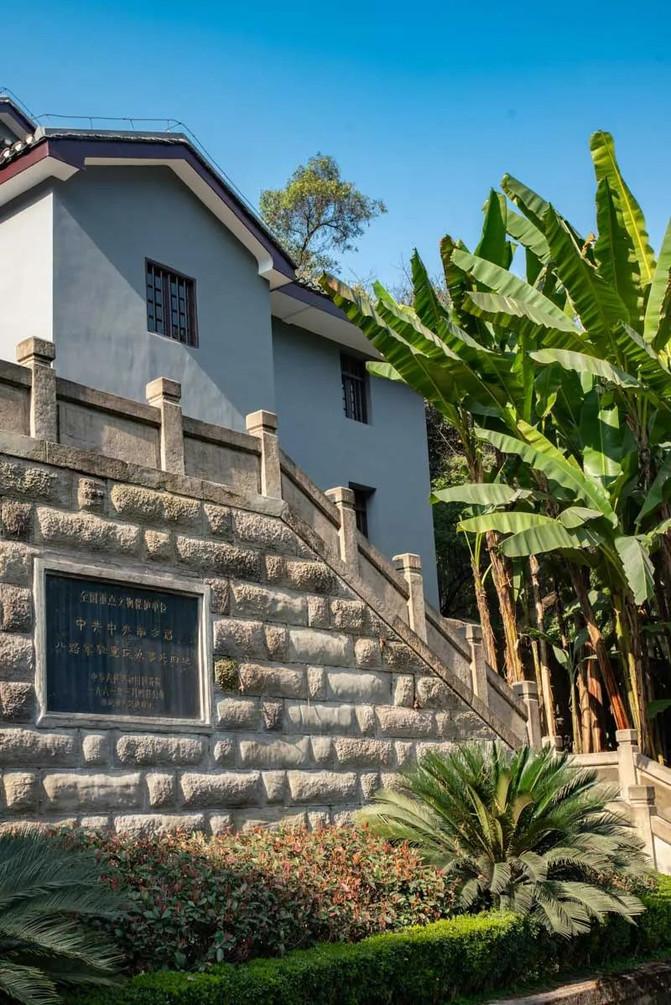
Map of the Former Site of the Eighth Route Army Office in Chongqing/Youlikeke
It can be imagined how many profound instructions that influenced the Chinese revolution were sent to the whole country and even the world in this building, and how many events that guided the direction of the revolution occurred here.

Group photo of some staff members of the Eighth Route Army's Chongqing Office
The bottom layer here is the public office of the Eighth Route Army stationed in Chongqing (the New Fourth Army stationed in Chongqing also worked here before the Wannan Incident); The second floor is the office and bedroom of the Southern Bureau and its leaders. Zhou Enlai's office and bedroom are the places where the responsible comrades of the Southern Bureau often hold meetings and make major decisions; The largest room on the second floor is the library of the Southern Bureau and Office; The third floor is the confidential department and secret radio station of the Southern Bureau and Office, mainly responsible for communication with relevant radio stations in Yan'an and other regions, as well as the transmission of confidential documents.

Map of the Former Site of the Eighth Route Army Office in Chongqing/Youlikeke
With the increase of personnel, comrades from the Southern Bureau built auditoriums and guesthouses in the farm, and Hongyan Village gradually became the work and life headquarters of comrades from the Southern Bureau of the Communist Party of China Central Committee.
Until today, these ruins have been fully preserved in Hongyan Village, maintaining the solemn and fearless appearance of that time.

View of the Former Site of the Eighth Route Army Office by You Lick
In 1985, 81 year old Deng Yingchao returned to Hongyan Village. At that time, she said affectionately in front of Rao Guomo's tomb, "We should not forget Rao Guomo. Without Mrs. Liu, where would our Hongyan come from
And Rao Guomo's response to his righteous act was: when he triumphed and sang, Hongyan was the home of everyone.
04
The small liberated areas in the Nationalist controlled areas
"Hongyan Village became the command center of the CPC in the Kuomintang controlled area and the mainstay of the anti Japanese national united front during the Anti Japanese War. At that time, the people in the rear area affectionately referred to Hongyan Village as the "Fog City Bright Lamp" and the "Small Liberated Area of the Nationalist controlled Area".

Architectural drawings in Hongyan Village/Youlik
On the night of January 17, 1941, Zhou Enlai was filled with grief and anger here, and wrote with his brush the timeless famous lines exposing the Kuomintang's stubborn faction's creation of the "Wannan Incident": "An eternal injustice, a single leaf in Jiangnan, fighting against each other in the same room, why rush to overthrow each other" and "mourning for those who died and suffered in Jiangnan".
In 1942, Deng Yingchao established a daycare center in Hongyan Village, with a maximum of over 30 children. At the beginning of the class, the children often cried out because they couldn't find toys to play with. Upon learning of this, the attentive Zhou Enlai said, "Children are descendants of the revolution, treasures of our country, and our successors. Everyone should care about them." He mobilized the staff to make various toys for the children.

Hongyan Village - Monument to the 110th Anniversary of Zhou Enlai's Birth/Youlik
During the peace negotiations between the Kuomintang and the Communist Party in Chongqing from August to October 1945, Chairman Mao Zedong stayed in Chongqing for 43 days.
During these days, except for three days when he was invited by Chiang Kai shek to live in Shandonglin Garden, Mao Zedong lived in Hongyan Village for the remaining 40 days.
During the day, he worked in Guiyuan and met with people from all walks of life, or went to Teyuan to discuss national affairs with democratic activists. At night, he returned to Hongyan Village to work and live.

Red Rock Village - Mao Zedong Office Map/Luo Dawan
In Hongyan Village, Chairman Mao not only commanded the Shangdang Campaign and made a major strategic deployment to march northeast, but also rewrote the 1936 poem "Spring Snow in Qinyuan" on a square table in Hongyan Village and presented it to democratic activist Liu Yazi. This poem was magnificent and caused a sensation throughout Chongqing, attracting attention from all walks of life at home and abroad.
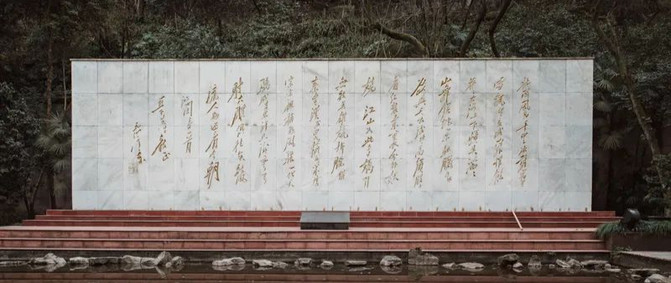
Hongyan Village - Stone Carving of "Spring Snow in Qinyuan" by You Lick
It is said that major newspapers in the capital are competing to reprint and publish a large number of singing and harmony works, forming a "Qinyuan Spring" craze in the cultural circle. Even some restaurants collect dozens of poems from "Qinyuan Spring" and hang them in their stores to attract customers.

Hongyan Village - Dayou Farm Site Map/Youlik
In May 1946, the Nationalist Government moved eastward to Nanjing. Zhou Enlai and Dong Biwu led the Communist Party delegation, Southern Bureau, and office staff to leave Chongqing and move to Nanjing one after another.
Before leaving, Dong Biwu wrote the four words "Dayou Farm" for Ms. Rao Guomo, and even wrote the seven character quatrain of "Dedicated to Ms. Rao Guomo": "After eight years of success in the rear, the Red Rock has supported us with few worries. The elegant residence has a thriving garden and forest, and customers are busy planting flowers and bamboo
Recorded, witnessed, and remembered.

05
The Xinhua Daily in Hutouyan
The Kuomintang does not allow Communist Party organizations to operate within the Nationalist controlled areas, "the staff of the Red Rock Revolution Memorial Hall told us
How can we resolve sibling conflicts and jointly resist foreign aggression?
In addition to the military and civilians in the liberated areas rising up to counter the stubborn actions of the Kuomintang, the Southern Bureau opened up a "second front" within the Nationalist controlled areas, using struggle to maintain unity, and Chongqing became the center of public opinion in the Nationalist controlled areas.
Hutouyan is the core point of this public opinion center - the former headquarters of Xinhua Daily, which is located here.

The headquarters of Xinhua Daily in Hutouyan, Yuzhong District, Chongqing
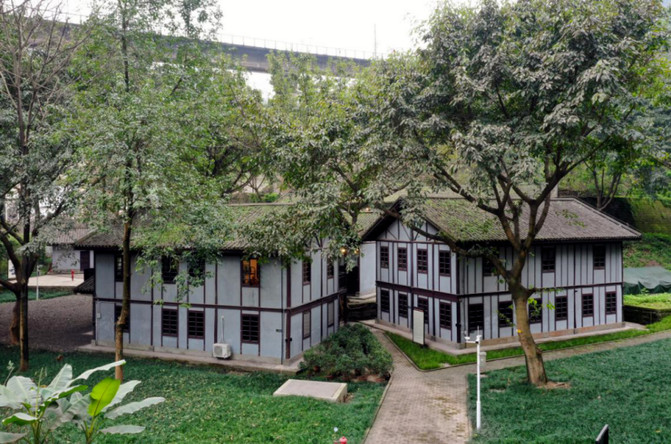
Map of the Former Site of Xinhua Daily Headquarters/Lu Gang
The former headquarters of Xinhua Daily is located at No. 86 Hutouyan Village, Yuzhong District. The main building consists of 5 floors of bamboo and wood, with a civil structure and black and white stripes, built along the mountain terrain.
From January 1938 to February 1947, under the political pressure of the stubborn faction of the Kuomintang, the news editing and distribution of Xinhua Daily were blocked and subjected to strict censorship. Comrades have also taken corresponding measures to deal with it. When a manuscript is deducted or deleted, some will "open the window", while others will mark the deleted area with the xx symbol.

Overlooking the headquarters of Xinhua Daily
The printing press currently housed in the Chongqing Hongyan Revolutionary History Museum is the best witness to this period of history -224 centimeters long, 154 centimeters wide, and 153 centimeters high, weighing about 1 ton, imported from Germany, equipped with Siemens motors, and finely printed, making it a powerful tool for newspaper publishing at that time.
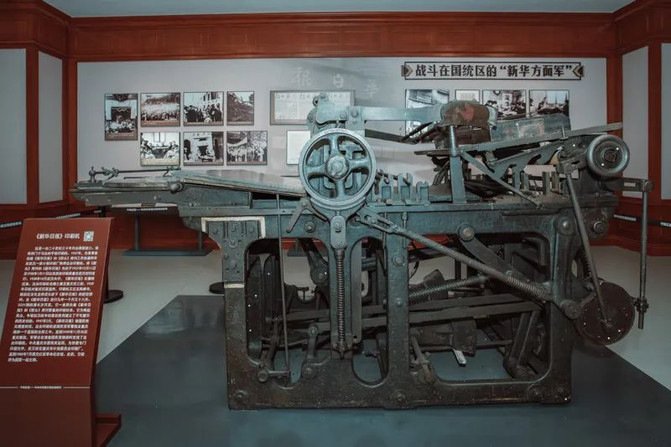
The printing press image used by Xinhua Daily back then/Yulike

After the Wannan Incident in 1941, on this machine, Zhou Enlai transformed his eternal famous line written in Hongyan Village into lead letters, shouting out to the whole society: "An eternal injustice, a single leaf in Jiangnan; why rush to fight against each other in the same room.
People's hearts turn their backs, thus seeing.
06
Xinhua Front Army
The "Xinhua Daily" and the "Masses" weekly magazines published by the "Xinhua Daily" are the only newspapers published by the CPC in the Kuomintang ruled areas during the War of Resistance against Japan and the War of Liberation. They were founded in Wuhan during the early stages of the national resistance war, on January 11, 1938 and December 11, 1937, respectively. Since its inception, we have been working together and fighting side by side.
In October 1938, Wuhan fell and the newspaper moved to Chongqing. By the time the newspaper was shut down by the Kuomintang in February 1947, Xinhua Daily had been running for 9 years.
Over the course of 9 years, the headquarters of Xinhua Daily remained in Hutouyan for 7 and a half years, publishing and distributing more than 2700 issues.

Zhou Enlai and some comrades from Xinhua Daily and Masses Weekly took a group photo
The Southern Bureau timely exposed the true face of the Kuomintang through the propaganda platform of Xinhua Daily, while making friends and strengthening the united front work in various aspects such as the Kuomintang, democratic parties, cultural and educational circles, business circles, and local power groups. It developed progressive forces, won over the middle forces, isolated stubborn forces, and took advantage of Chongqing as the wartime capital, gathering foreign embassies and news agencies to carry out international anti fascist united front work, which gained support from international public opinion.

Xinhua Daily Business Department on Minsheng Road in the urban area of Chongqing
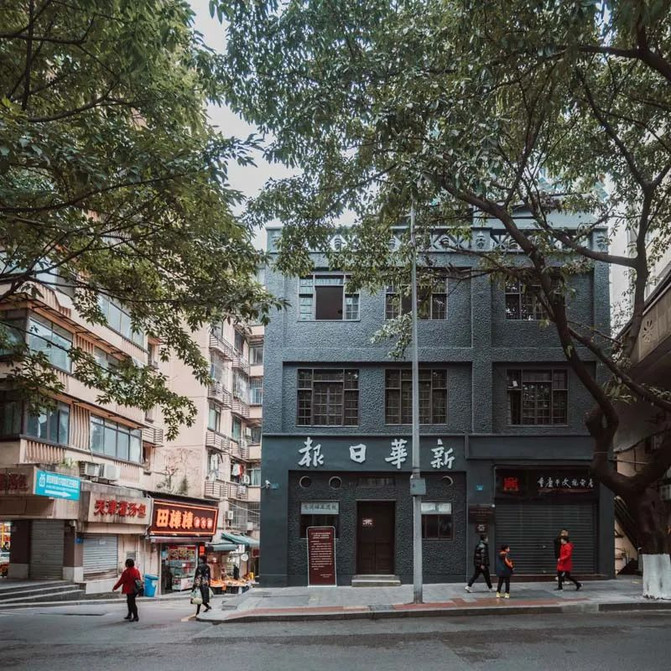
The old site of the Xinhua Daily Business Department today/Youlik
Every time the Kuomintang deviates from the direction of the joint resistance war, the Southern Bureau will use the Xinhua Daily to mobilize public opinion for strong condemnation. Chiang Kai shek, who claims to be the 'supreme commander of the resistance war', dare not go further on the path of 'actively opposing communism and passively resisting Japan', "said a staff member of the Hongyan Revolutionary Memorial Hall. It was precisely because the Southern Bureau endured humiliation and carried out negotiations and mediation that the situation of the second cooperation between the Kuomintang and the Communist Party was maintained until the final victory of the resistance war, and the historical contribution of Hutouyan cannot be erased.

The sample of Xinhua Daily at that time
Therefore, later on, Comrade Mao Zedong praised the brave Xinhua journalists who fought bravely under the Tiger Head Rock as the "Xinhua Front Army".
This is the highest honor for journalists.
07
Zhou Gongguan's Meeting of the Wind and Clouds
In the concept of the Red Three Rocks, No. 50 Zengjiayan, Zhongshan Fourth Road, Shangqing Temple - Zhou Gongguan, Guiyuan, and Teyuan are geographically close, so the three places are collectively referred to as Zengjiayan.
But this small area along Zhongshan Fourth Road was the site of the most significant events that influenced the direction of modern Chinese history; It is also a rare place in human political history where the intelligence agencies of hostile parties live adjacent to each other.
Amazing.

The repaired map of Zhou Gongguan Square/Yulike
And Guiyuan witnessed the renowned "Chongqing negotiations"; Teyuan is the birthplace of the Chinese Democratic Party and the current location of the "Teyuan · Chinese Democratic Party History Exhibition Hall".


Special Garden Map/Youlik

Guiyuan Map/Youlik
Zhou Mansion is a place where the older generation of proletarian revolutionaries such as Zhou Enlai, Dong Biwu, Ye Jianying, Wang Ruofei, Wu Yuzhang, Deng Yingchao fought, worked, and lived. The cultural committee, women's group, foreign affairs group, military group, and united front committee under the Southern Bureau also have offices here.
Nowadays, during festivals, this place is crowded with tourists, but little is known about the dangers and tricks that happened here back then.

The bronze statue of Zhou Enlai on the Zhou Mansion Square/You Lick
Zengjiayan No. 50 has three floors. At that time, most of the first floor, a small part of the second floor, and the entire third floor were leased, and most of the second floor was actually used by the Kuomintang.
Although it was the second period of cooperation between the Kuomintang and the Communist Party at that time, the White Terror was pervasive in the Nationalist controlled areas.
Therefore, sometimes after Zhou Enlai and other leaders and staff of the Southern Bureau entered No. 50 Zengjiayan, Nationalist military, police, and special agents would follow them. The required battle of wits and courage at that time was more thrilling than spy movies.

The balcony of Zhou Mansion by the Jialing River
Please imagine that to the left of No. 50 Zengjiayan is the mansion of Dai Li, the head of the Kuomintang Military Intelligence Special Forces, and to the right is the police station of the Kuomintang Police Department. Outside the gate, there are also "tea houses" and "cigarette stalls" set up by the special forces, making the environment very dangerous.
In 1958, Dong Biwu, who had lived here for many years, revisited the old place and wrote an interesting limerick out of interest: "Eight years of anti Japanese living here, 'Three Strikes and Maintenance Support' brings new laughter and joy. Dai Li is on the right side of the neighbor, always looking at people passing through the north and south.
The meaning of this poem is: During the War of Resistance Against Japan, they persisted in their work here for eight years, and "San Da Wei Zhi" is the transliteration of the English phrase "sandwich bread with ham".

The Old Shadow of Zhou Mansion after Liberation
This is a description of the environment at that time. In the general environment, Kuomintang spies surrounded the "Zhou Mansion", but in the Zhou Mansion, the Southern Bureau had an absolute advantage. The first and third floors of the Southern Bureau sandwiched the Kuomintang in the middle like bread with ham. And the spy leader Dai Li is always eyeing the passersby in front of the door.
Experience the thrilling past with ease.
It can be described as wonderful and magnificent.

In October 1985, Deng Yingchao returned to No. 50 Zengjiayan and waved to the crowd at the entrance
08
Foggy Season Performance and International Stage
After the Anhui Incident in 1941, the White Terror in the Nationalist controlled areas became increasingly rampant, and the political atmosphere in the mountainous city of Chongqing was suppressed to the extreme; The cooperation between the Kuomintang and the Communist Party has been disrupted, and the anti Japanese national united front is in crisis.
But in the face of a great enemy, some political parties and individuals outside the Kuomintang and the Communist Party who advocate resistance against Japan urgently hope to unite.
Therefore, under the leadership of the Southern Bureau, the Cultural Affairs Commission discussed with the literary and performing arts circles in the capital to take advantage of the foggy climate in Chongqing from October to April of the following year, which makes it difficult for Japanese planes to carry out bombings, and to hold public performances of plays to consolidate the enthusiasm of the entire nation for resistance and defend the country.
The performance lasted for 4 sessions, with a total of more than 100 plays performed, including famous plays such as "Spring and Autumn of the Heavenly Kingdom", "The Flower of Tangdi", "Qu Yuan", etc. All performances were sold out. Therefore, this performance not only became a golden age in the history of Chinese drama, but also greatly inspired the people of the Nationalist controlled areas to persist in the fighting spirit of the Anti Japanese War, consolidated the anti Japanese national united front, and was known as the "Wuji Performance" in history.

Still from 'Qu Yuan'
At that time, the capital was not only the last fortress of the Anti Japanese War and the center of national solidarity, but also the stage of international politics, where foreign missions and consulates gathered.
Under the leadership of Zhou Enlai, the Foreign Affairs Group of the Southern Bureau has won the understanding and support of the CPC from international friends from all walks of life by publicizing the foreign affairs work policy, which has facilitated major historical activities such as the visit of Chinese and foreign press groups to Yan'an, the arrival of the US military observer group in Yan'an, and Dong Biwu's role as a member of China's delegation to the United Nations Conference in San Francisco.
This enabled the CPC to step out of the border area and onto the international political stage.

On June 26, 1945, Dong Biwu signed the United Nations Charter

In 1945, Chairman Mao had a conversation with the US Ambassador to China, Hurley, and others in Yan'an
And this foreign affairs team has also gained good experience in such an environment.
After the establishment of the People's Republic of China, many staff members in the group became excellent diplomats of the republic, galloping in the field of diplomacy. Famous diplomatic couples Qiao Guanhua and Gong Peng also worked in the group at that time.
09
Cradle of Chinese Democratic Parties
There is a mansion not far from the Jialing River direction on the turntable of Shangqing Temple, called Teyuan. It was the former residence of the famous patriotic and democratic figure Xianying during the Anti Japanese War. Because Xianying's character is "Te Sheng", it is also called Teyuan.
In March 2004, the United Front Work Department of the Central Committee of the Communist Party of China decided to establish the first "Traditional Education Base of the Chinese United Front" here, as well as a united front propaganda and education joint line led by the "Special Garden · Chinese Democratic Party History Exhibition Hall".

Chinese Democratic Party History Exhibition Hall Picture/Youlik
The reason for building the exhibition hall here is that Chongqing is an important birthplace of China's democratic forces - it was with the support and assistance of the Southern Bureau that domestic democratic parties emerged here, and four of the eight contemporary democratic parties in China were successively established and flourished in Chongqing, forming the foundation of a new democratic movement.

Monument to the Establishment of the Chinese Democratic League/Youlik
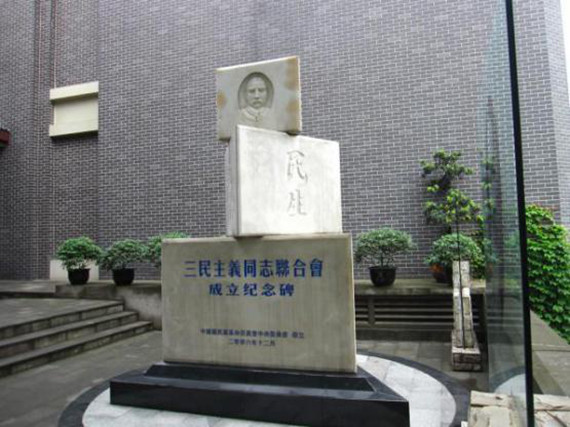
Monument to the Establishment of the Three Principles of the People Comrades' Federation by Luo Dawan
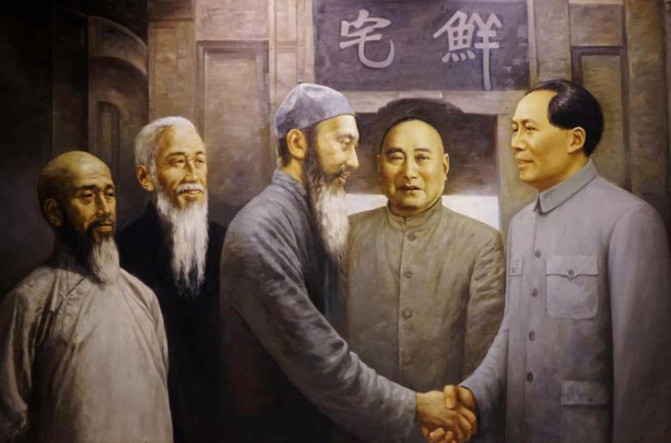
Oil painting created based on the scene of Mao Zedong's Three Gu Special Garden during the Chongqing negotiations
In order to commemorate the contribution of Teyuan to the revolutionary cause, Dong Biwu once proposed to gift Teyuan with the title of "Democratic Home", and later Feng Yuxiang handwritten the plaque of "Democratic Home" for him. At the 60th birthday banquet of Xianying, Chairman Mao went to the banquet and saw the four big characters "Democratic House" at the entrance of the special garden. He praised them highly, saying, "Dong Lao's name, General Feng's character, and the couplet given by the old man can be called three wonders
This is truly the cradle of China's democratic parties.

Under the promotion of the Southern Bureau, the democratic forces were flourishing at that time, which played a fundamental role in promoting the transformation of the middle forces into democratic forces, clarifying the struggle objectives of democratic forces, promoting the formation of a new pattern of democratic politics, and even ultimately establishing the multi-party cooperation and political consultation system led by the CPC after the founding of New China.
Today, this exhibition hall has become the only comprehensive exhibition hall in China that fully reflects the multi-party cooperation and political consultation system led by the CPC. In May 2013, the special park was announced as a national key cultural relics protection unit. In 2020, the special park was announced as the third batch of national level anti Japanese war sites, quietly telling the story of the past for future generations.
ten
Red Three Rocks, Waiting for Red Hearts in the Distance
As the tide of history slowly recedes, Hongyanzui, Zengjiayan, and Hutouyan have already ended their original missions and quietly transformed their roles.
The former site of the Southern Bureau of the Communist Party of China Central Committee and the Eighth Route Army Office in Chongqing, Hongyanzui, has been transformed into Hongyan Village, and the Hongyan Revolution Memorial Hall has been established; The Zhou Mansion and Guiyuan at No. 50 Zengjiayan, as important historical sites, have regained their glory after renovation, and the "Special Garden · Chinese Democratic Party History Exhibition Hall" and "Chinese United Front Traditional Education Base" have been established in the Special Garden; The former site of the Xinhua Daily headquarters in Hutouyan has also regained its busy figure and turbulent years through restoration.

Main entrance of the Red Rock Revolution Memorial Hall/You Lick
We hastily sketch, but it is far from enough to showcase the profound and great resilience of the Red Rock spirit carried on this red land of Chongqing. Yuzhong, Chongqing, and China are developing rapidly, and as these histories slowly pass through the glorious years of nearly a hundred years, they may be waiting for future generations to rediscover, explore, and reminisce.

Step map outside the Red Rock Revolution Memorial Hall/Youlik
This time, the Red Three Rocks project has included three major areas in the overall planning: Hongyan Village Hutouyan Hualong Lake, Liziba Eling Fotuguan International Village, Zhongshan Fourth Road Grand Hall Datianwan Cultural Palace, etc., covering a total of 78 cultural relics, including 23 revolutionary cultural relics, as part of the overall planning and improvement. This is our deep reflection on the passionate years of the past.
Because this is the source of our homesickness, spiritual home, and hometown of life.

Sculpture in the Red Rock Revolution Memorial Hall/Yulike
The construction of the Red Three Rocks and the organic renewal of the city will go hand in hand. We can foresee that in the future, the red culture in Yuzhong District will shine even brighter and become more harmoniously integrated into the fabric of life; The cultural landscape and natural scenery of the "Two Rivers and Four Banks" will also be strung together in chains and connected in patches, gathering in a brand new appearance to welcome visitors.

Red Rock Square Map/Yulike
The spirit of Hongyan is the valuable spiritual wealth of the CPC and the Chinese nation, the unique spiritual beacon in the Chinese revolutionary spirit pedigree, and the important coordinate of the centennial history of the CPC.
The Red Rock Spirit, along with the Red Boat Spirit, Jinggangshan Spirit, Long March Spirit, Yan'an Spirit, Xibaipo Spirit, etc., together constitute the complete lineage of the Chinese revolutionary spirit.

This beautiful red land, the birthplace of the Red Rock spirit, is bound to become a national red cultural landmark, a first-class patriotic education base, and a red cultural tourism destination.
It will patiently wait for the red hearts in the distance,
Slowly walk towards it.
Previous Article:Eating Memories of Chongqing, Traveling Memories of Mountain City
Next Article:Chongqing Niigaro Hotel | Conquer the Two Rivers Cloud Nightlife Guide
